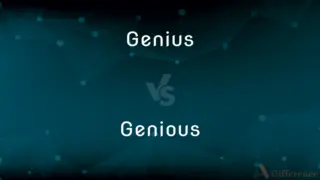Plant Cell vs. Animal Cell — What's the Difference?
By Tayyaba Rehman — Published on October 15, 2023
Plant cells have a rigid cell wall, chloroplasts, and large vacuoles, while animal cells lack these structures and have small vacuoles.

Difference Between Plant Cell and Animal Cell
Table of Contents
ADVERTISEMENT
Key Differences
Plant cells are fundamental units of plants and have distinct features that support their photosynthetic nature and static existence. In contrast, animal cells are the basic building blocks of animals and are equipped to support movement and higher metabolic rates.
Tayyaba Rehman
Oct 15, 2023
Chloroplasts, essential for photosynthesis, are found in plant cells, allowing them to produce their food. Animal cells, lacking chloroplasts, rely on the intake of nutrients from external sources.
Tayyaba Rehman
Oct 15, 2023
The most noticeable difference between plant cells and animal cells is the presence of a cell wall in plant cells. This rigid structure, composed mainly of cellulose, provides support and protection. Animal cells, on the other hand, possess a flexible cell membrane without a surrounding cell wall.
Tayyaba Rehman
Oct 15, 2023
Another distinction is the central vacuole in plant cells, which stores water and maintains turgor pressure. Animal cells have smaller vacuoles and do not play a significant role in maintaining cell shape or size.
Tayyaba Rehman
Oct 15, 2023
While both plant cells and animal cells have mitochondria, it's notable that plant cells utilize both mitochondria and chloroplasts for energy production, while animal cells rely solely on mitochondria.
Tayyaba Rehman
Oct 15, 2023
ADVERTISEMENT
Comparison Chart
Outer Layer
Has a rigid cell wall made of cellulose.
Lacks a cell wall; has a flexible cell membrane.
Tayyaba Rehman
Oct 15, 2023
Organelles for Energy
Contains chloroplasts for photosynthesis.
Does not have chloroplasts.
Tayyaba Rehman
Oct 15, 2023
Vacuoles
Large central vacuole for storage and maintaining cell shape.
Smaller vacuoles without a significant role in cell shape.
Tayyaba Rehman
Oct 15, 2023
Lysosomes
Less common.
Commonly present and play a role in digestion within the cell.
Tayyaba Rehman
Oct 15, 2023
ADVERTISEMENT
Definitions
Plant Cell
Enclosed by a rigid cell wall.
The plant cell's cell wall provides it with support and protection.
Tayyaba Rehman
Oct 02, 2023
Animal Cell
Contains small vacuoles and lysosomes.
The animal cell uses lysosomes for intracellular digestion.
Tayyaba Rehman
Oct 02, 2023
Plant Cell
Typically maintains a fixed, rectangular shape.
Due to its cell wall, the plant cell retains a specific shape.
Tayyaba Rehman
Oct 02, 2023
Animal Cell
Has a more varied and rounded shape.
The shape of an animal cell can change according to its function.
Tayyaba Rehman
Oct 02, 2023
Plant Cell
Contains chloroplasts for photosynthesis.
The plant cell harnesses sunlight to produce food.
Tayyaba Rehman
Oct 02, 2023
Animal Cell
Relies on mitochondria for energy production.
In the animal cell, the mitochondria play a central role in energy conversion.
Tayyaba Rehman
Oct 02, 2023
Plant Cell
The basic structural unit of plants.
The plant cell has a large central vacuole.
Tayyaba Rehman
Oct 02, 2023
Animal Cell
The basic structural unit of animals.
The animal cell has various organelles, including the nucleus.
Tayyaba Rehman
Oct 02, 2023
Plant Cell
Participates in both photosynthesis and cellular respiration.
A plant cell utilizes its mitochondria and chloroplasts for energy.
Tayyaba Rehman
Oct 02, 2023
Animal Cell
Lacks chloroplasts and cell walls.
The animal cell is flexible due to the absence of a rigid cell wall.
Tayyaba Rehman
Oct 02, 2023
FAQs
Do both plant cells and animal cells have a nucleus?
Yes, both plant cells and animal cells have a nucleus that contains genetic material.
Tayyaba Rehman
Oct 15, 2023
What's the primary energy-producing organelle in plant cells?
Plant cells use both chloroplasts (for photosynthesis) and mitochondria (for cellular respiration).
Tayyaba Rehman
Oct 15, 2023
Are vacuoles exclusive to plant cells?
No, while plant cells have a large central vacuole, animal cells also have vacuoles, but they are smaller.
Tayyaba Rehman
Oct 15, 2023
What is the primary function of the cell wall in plant cells?
The cell wall provides support, protection, and maintains the shape of the plant cell.
Tayyaba Rehman
Oct 15, 2023
Do animal cells undergo photosynthesis?
No, animal cells lack chloroplasts and do not undergo photosynthesis.
Tayyaba Rehman
Oct 15, 2023
Why do animal cells not have a rigid shape like plant cells?
Animal cells lack the rigid cell wall that plant cells have, resulting in a more flexible shape.
Tayyaba Rehman
Oct 15, 2023
What is the role of chloroplasts in plant cells?
Chloroplasts in plant cells are responsible for photosynthesis, converting light energy into chemical energy.
Tayyaba Rehman
Oct 15, 2023
Are lysosomes more common in plant cells or animal cells?
Lysosomes are more common and prominent in animal cells.
Tayyaba Rehman
Oct 15, 2023
How do animal cells get their nutrients?
Animal cells obtain nutrients from external sources since they cannot perform photosynthesis.
Tayyaba Rehman
Oct 15, 2023
Do both plant and animal cells have a cell membrane?
Yes, both plant and animal cells have a cell membrane that regulates the movement of substances in and out of the cell.
Tayyaba Rehman
Oct 15, 2023
Author Spotlight
Written by
Tayyaba RehmanTayyaba Rehman is a distinguished writer, currently serving as a primary contributor to askdifference.com. As a researcher in semantics and etymology, Tayyaba's passion for the complexity of languages and their distinctions has found a perfect home on the platform. Tayyaba delves into the intricacies of language, distinguishing between commonly confused words and phrases, thereby providing clarity for readers worldwide.

















































